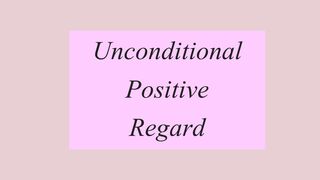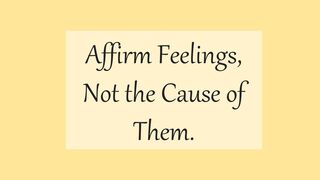Narcissism
Can Affirmation in Therapy Worsen Narcissism?
When is affirming a client harmful in mental health counseling?
Posted September 20, 2022 Reviewed by Michelle Quirk
Key points
- Affirming a client's feelings is an important part of counseling.
- When the counselor affirms faulty beliefs, this can keep a client stuck in narcissism.
- Counselors need to separate affirmation of feelings the client has and affirmation of the reasons behind those feelings.

This post focuses on affirmations used by mental health professionals with clients in counseling situations. The idea of a counselor affirming a client became popular with Carl Rogers’s (1961) emphasis on giving unconditional positive regard to the client as a person. As the counselor acknowledges the client’s feelings and accepts that client as a person, this opens up self-acceptance and the courage to explore one’s hurting inner world. Affirmations can be as simple as a “yes” or “I understand” or some other acknowledgment of the client’s statements that reflects inner subjective states.
Unconditional Positive Regard
Affirmation centers on the feelings the client brings to the therapeutic process and on the worth of the client as a person. In other words, the client is not subtly chastised for being angry or for feeling jealous or for having any other negative feeling that is considered less than acceptable in civil society. Rogers used the word “unconditional” to emphasize that the client does not have to do anything to earn this positive regard by the counselor. The regard, the valuing of the client’s worth, is a given and it is supposed to be part of therapy regardless of whether that therapy is Rogerian humanistic therapy or psychoanalysis or cognitive-behavioral therapy or any other kind of psychological treatment. In other words, unconditional positive regard is considered to be a common factor in mental health treatment and not a specific technique to be used in a particular model of treatment (Lambert and Bergin, 1994).

Affirmation or unconditional positive regard is supposed to strengthen the therapeutic bond between counselor and client and, therefore, make future sessions together more productive for the client. The positive effects of affirmation are generally accepted within the mental health profession. Yet, some rather rare research asks us as mental health professionals to stop and examine in greater detail this issue of affirmation. The caution centers on this important distinction: The counselor has to be very careful in separating feelings within the client and the client’s narrative of what is causing those feelings. Feelings about a situation and the situation itself need to be examined independently.
Affirming Faulty Stories
Here are two examples of what I mean. In an early work by Johnson and Matross (1977), the authors raised a concern about mental health professionals affirming faulty stories, those that are not true but are intended by the client, for example, to blame others and avoid taking responsibility for inappropriate behavior. Affirming the cause of the feelings (“I feel mad because people do not always do what I want”) may reinforce false beliefs in the client and therefore perpetuate a continuation of such unhealthy behaviors. It may reinforce the story the client is telling the self of how others are always wrong and how the self is always right. Karpiak and Smith Benjamin’s (2004) research supported this view.
For example, based on inter-rater judgments of the researchers, when a client seemed to have a pattern of dominating others, and when that client made strong statements of wanting to be inappropriately assertive, then the counselor’s even indirectly (“yes,” or “uh-huh,” for example) affirming this desire reinforced this maladaptive pattern rather than changed it to a more temperate way of interacting. In other words, the client who dominated others continued to want to do so when the counselor affirmed the desire (with a “yes” or “I understand” or even a restatement of the client’s words). The point is this: Counselors need to affirm the personhood in the client and affirm the feelings as they are, but this should not lead to the error of affirming the client’s current understanding of why such feelings are present.
I experienced this same issue when a person came to me for help. He had separated from his partner because, according to the client, “I just could not take any more of her demands.” He was seeing two other counselors at the time, and each one was reinforcing the idea that the partner was intolerable, based on the client’s feelings and statements. Yet, when I asked for specifics about “her demands,” the client could not produce concrete examples of what such intolerable behaviors were. The more we talked, the more it became clear that the partner tried hard to keep the relationship together. According to the client, his partner went to their friends to ask for help in preserving the relationship. The client saw this as an outrageous annoyance rather than as a possible courageous effort to save the partnership.

I came to realize, after many talks together, that the client was closed to the possibility of examining his own behavior relative to his former partner. He kept falling back on the statements of his other counselors: “They are telling me that my feelings of exasperation are correct and that I, therefore, am in the right.” He was in denial that the breakup might be a two-way street or even a one-way street in which he was engineering the breakup for his own advantage. That advantage, at the time of therapy, was his interest in another woman.
As it turned out, he was resistant to encouragements to examine the cause of the breakup as he continued to cling to the connection between his feelings (anger at the partner) and the cause (she is entirely responsible). He was closed to growing as a person, to growing in humility, and in seeing that he may be harboring narcissistic tendencies that are not helping him or his former partner (nor the new partner who may be an unsuspecting victim of his self-centered worldview). In the end, it was his firm belief in the other two counselors, who were affirming both his feelings and his likely incorrect conclusions about the causes of those feelings, that was hurting the client.
I took a chance, after many talks, and referred to his counseling efforts with the other two counselors as “vanity therapy.” By this, I meant that he was paying a lot of money to professionals so that they could validate his beliefs, with no challenge to change. I was met with silence. I continued to affirm his anger, but I did not affirm his ideas of its cause. His explorations of a genuine cause of those feelings might have set him free. I now wonder how he is doing in his new romance.
Affirmation has its place, but it can go too far in affirming all beliefs in a client who is in need of challenge to at least some of those beliefs.
References
Johnson, D.W., & Matross, R. (1977). Interpersonal influence in psychotherapy: A social psychological view. In A.S. Gurman & A.M. Razin (Eds.), Effective psychotherapy: A handbook of research (pp. 395– 432). New York: Pergamon Press.
Karpiak, C.P. & Smith Benjamin, L. (2004). Therapist affirmation and the process and outcome of psychotherapy: two sequential analytic studies. Journal of Clinical Psychology, 60, 659-676.
Lambert, M.J., & Bergin, A.E. (1994). The effectiveness of psychotherapy. In A.E. Bergin & S.L. Garfield (Eds.), Handbook of psychotherapy and behavior change (4th ed., pp. 143–189). New York: Wiley.
Rogers, C.R. (1961). On becoming a person. New York: Houghton Mifflin.




